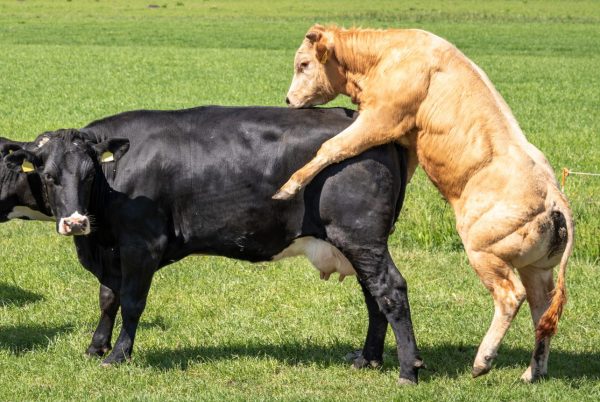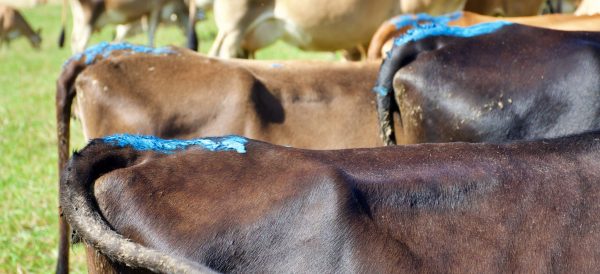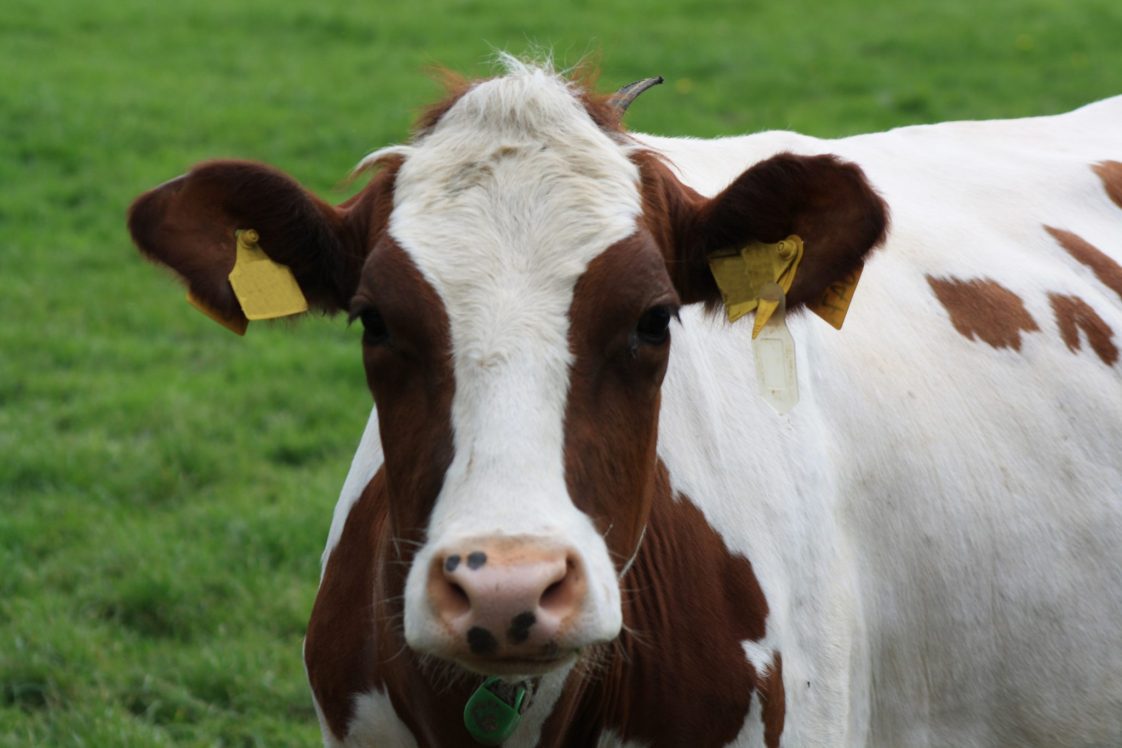Dairy

Estrus is a period each month when a cow is receptive to reproduction via a demonstration of behavior such as receptivity to mounting. Detecting estrus in cattle is crucial to the success of a dairy operation. To maximize this detection, it is important to use effective estrus detection aids in addition to vigilant and frequent monitoring for observable behaviors.
Estrus is Latin for desire and is often referred to as heat or bulling. Estrus occurs when the female of a species is receptive to the sexual advances of the male. Estrus typically lasts for about 18 hours; however, about a third of observed periods lasted fewer than 12 hours and some as few as 7 hours. The behavioral and physical characteristics of estrus including the following:
- Standing to be mounted
- Rough hair on the tailhead from being mounted
- Increased restlessness and bawling
- Increased interaction with other cows (mounting, nudging, sniffing)
- Raised tailhead and swollen vulva
- Clear mucus discharge from the vulva
Anestrus
The major problem for dairy producers is not estrus but anestrus, which is the lack of estrus activity. Keep in mind, however, that anestrus is normal during the following three reproductive stages:
- Before puberty (prepuberal anestrus)
- During pregnancy
- For a short period after calving (postpartum anestrus)
Prepuberal anestrus is usually not a problem in dairy heifers. It is most economical for a heifer to have her first calf at 24 months of age. Considering the normal gestation length of about 9 months, heifers must conceive by no later than 15 months of age. Well-fed dairy heifers normally reach puberty before 12 months of age, depending on the breed; however, under- nourishment can delay puberty.
Pregnancy is a desirable anestrous condition, but failure to recognize that a cow is pregnant can lead to the belief that she is simply not showing estrus and has a reproductive problem. Too frequently, cows culled for reproductive problems have been discovered at slaughter to be pregnant. A routine health and pregnancy detection program will limit these mistakes and losses.
The postpartum anestrous period is the time after parturition that is necessary for recuperation and reorganization of the brain and reproductive organs. Dairy cows normally ovulate within 3 weeks after calving, but this first ovulation is not normally accompanied by behavioral estrus.
The corpus luteum resulting from first ovulation usually has a short lifespan, and the cow will ovulate again in 15 to 21 days. Forty to 80 percent of dairy cattle show estrus at second ovulation. By 60 to 70 days postpartum, almost all cows should have ovulated three times and shown estrus at least once.
Financial Considerations
After a dairy cow calves, she produces milk in a predictable pattern called a lactation curve. As shown in the graph on page 4, a cow’s milk production is highest in early lactation and then declines steadily.
Each new lactation must be initiated by calving; therefore, to maintain a yearly milk production cycle, a cow must maintain a yearly pregnancy cycle. Pregnancy in dairy cattle averages 280 days. If you maintain a yearly calving cycle, that leaves only 85 days from the time a cow calves until she must conceive again.
 Because a cow requires a fairly constant level of feed for maintenance, whether she is producing milk or not (the dry period), you would expect a point sometime in late lactation when it costs more to feed a cow than there is income from the sale of her milk. At this breakeven point, the cow could be dried off and her udder allowed to recover for the next lactation.
Because a cow requires a fairly constant level of feed for maintenance, whether she is producing milk or not (the dry period), you would expect a point sometime in late lactation when it costs more to feed a cow than there is income from the sale of her milk. At this breakeven point, the cow could be dried off and her udder allowed to recover for the next lactation.
Dairy economists have studied various lengths of lactation with differing lengths of dry periods to determine the most profitable combination. In the average dairy cow, this optimum combination is 305 days in lactation with 60 days dry, adding up to a 365- day (12-month) milk production cycle.
Other studies have shown that cows that first calved at 24 months produced the most milk per day of life. It has become widely recommended to calve dairy heifers at 24 months and to maintain a 12-month calving interval thereafter.
Missing an estrus period can be a costly problem for producers. For example, if a producer missed an estrus period and it cost $3 per cow per day and the cycle does not recur for 21 days, the producer would lose $63 per cow per cycle. If estrus periods continue to be missed, this cost can add up quickly.
Reasons for Not Detecting Estrus
Studies show that inadequate estrus detection is the major cause of extended intervals from calving to first breeding. In one study, dairy producers observed 1.7 estruses per cow but missed an additional 1.9, resulting in 40 extra days open.
About 10 percent of the reasons for undetected estrus is attributed to cow problems, while 90 percent can be attributed to people problems. A summary of these problems are as follows:
Cow Problems
- Static or nonfunctional ovaries
- Luteal cysts
- Pyometra resulting in a retained corpus luteum
- Weak or subtle signs of estrus
- Silent estrus
- Short duration of behavioral estrus
- Displaying estrus only at night
- Irregular estrous intervals (not at a 21-day interval)
People Problems
- Too few observations for estrous activity per day (need at least three)
- Observations at the wrong time of day (should be early morning and late evening)
- Observations during the wrong phase of the daily routine (best to observe when cows are loafing or on pasture, not while being fed or milked)
- Too little time spent per observation (at least 60 minutes needed each time)
- Lack of knowledge of primary/secondary signs of estrus`
Continuous observation of dairy cattle has shown that almost 70 percent of estrous activity occurs between 7 p.m. and 6 a.m. when producers are least likely to observe the cows. Less than one-fourth of the activity will occur in the feeding area. Very little will occur in the collecting area where most observations are made. The greatest activity can be seen in the free stall, loafing, and pasture areas.
Several managerial and environmental factors affect estrus detection. Larger herds increase the chance that more cows will be in estrus at the same time. Increased group activity encourages estrous activity and makes estrus easier to detect. However, larger herds usually result in less time spent observing each cow.
There are no conclusive effects of housing (tie-stall versus free-stall); however, secure footing is vital. Several studies show a dramatic increase in mounting activity in cows immediately after they have been moved to a dry dirt lot with solid footing.
Cows that calve in the spring usually have a longer interval until the first estrus, assumable because they resume ovarian activity during the warmer summer months when signs of estrus are less intense.
Increasing Estrus Detection
Several methods have been developed to increase the detection of estrus. These can be grouped into two categories: 1) methods that increase the detection of naturally occurring estrus; and 2) induction of estrus via synchronization when observation efforts can be intensified.
Listed below are some tips that can be used to maximize the detection of estrus in dairy cattle.
Observational Habits
To accurately determine the rate of cattle demonstrating signs of estrus, it is crucial to monitor the cattle frequently. Cattle are less likely to show obvious signs of estrus during milking and feeding when they are typically observed by producers. A study conducted at Colorado State University concluded that 95 percent of cattle under constant observation were determined to be in estrus, while only 56 percent of cattle were found to be in estrus when monitored twice per day. Penn State also conducted a study on observational frequency and estrus detection in cattle and reached a similar conclusion that frequent observations lead to increases in estrus detection. At the absolute minimum, cattle should be monitored in 60-minute intervals to accurately determine this reproductive receptivity within an average-size dairy herd. Additionally, a quarter of cows will bull for fewer than 6 hours, creating a need to observe cattle a minimum of three times per day. To conclude, cattle need to be observed frequently and for as long as possible to ensure maximal reproductive success.
Quality Recordkeeping
It is important to keep accurate and detailed records of previous detections of estrus and services for each cow within the herd. In addition, keep a list of cattle desired for breeding in an attempt to maximize efficiency while monitoring for signs of estrus. It is helpful to use a notebook to record behavioral observations in cattle in addition to logging this information into a computer system, calendar, or breeding chart that is accessible to all employees so they may also accurately monitor the cattle for signs of estrus. The use of a farm-wide logging system also helps predict when a particular cow will be nearing estrus and may need extra attention. It is very important to have good and clear communication among employees on the farm to accurately maintain estrus logs.
Cow Identification
While monitoring for signs of estrus, it is important to have clear and accurate forms of cattle identification to prevent mistakes such as servicing cattle that are not actually in estrus. Commonly used forms of identification include brands (heat or freeze), large ear tags, or a semipermanent painted number. While the specific choice of identification is the producer’s choice, the identification must be clear and easy to read at a distance.
Detecting Secondary Signs of Estrus
Secondary signs of estrus include restlessness, bawling, red and swollen vulva, vulvar discharge, hair rubbed up at the tail head and/or flanks, and chin resting. The following are methods for detecting secondary signs of estrus that may occur when the cattle are not under direct observation.
Observation. Observe cattle for mounting behavior at a minimum of 60-minute intervals three times per day, preferably when cattle are not in the milking parlor or feeding barn. Log observations into a breeding chart or calendar.
Androgenized female. A female can be treated with androgens to elicit mating behavior and to determine which cattle allow her to mount while having no risk of pregnancy with an undesired sire.
Palpation. Ovaries can be palpated by a trained professional to determine the presence or absence of follicles and/or a corpora lutea.
Chin-ball marker. A vasectomized or sterile bull can be fitted with a strap-on device that has a ball that essentially works as a ballpoint pen to mark the chin of cattle that are receptive to chin rubbing.
Pedometer. A pedometer can be attached to the leg of a cow to track the number of steps it takes within a desired time period to determine signs of restlessness.
Temporary marking. Paint or chalk can be applied above the tail head and later checked to see if it has been rubbed off due to mounting.

HeatWatch. This is a device that functions as a pressure switch and is glued to the tail head. When pressure is detected, a radio signal is sent to a computer system that logs the date, time, duration of the mount, and cattle identification.
CattleMax. This software can be used to record breeding and calving data, cattle weights, and medical information, as well as financial information and can easily be used across multiple devices.
Plan-A-Head. This software can be used to keep artificial insemination records, help monitor calving intervals, and flag cattle that have not calved annually. It can also be used to track cattle weights, medications, and feed information.
Abnormal Anestrus
It is important to have clear parameters set in advance to determine when to intervene if a cow is not displaying signs of estrus. The cow may be experiencing silent estrus or anestrus and is not entering into the estrus portion of the reproductive cycle at all. Silent estrus occurs when a cow is experiencing estrus but there are no observable signs or receptivity to mounting. Silent estrus typically occurs during the first estrus experienced after puberty but can also occur throughout adulthood.
Another concern with a lack of estrus signals is that the cow has not entered estrus at all and will not ovulate as a result. Both situations can be problematic as these cattle will not be bred to reproduce or some cattle may be labeled as infertile and will be culled even if they are fertile and only experiencing silent estrus. If a cow has not demonstrated signs of estrus throughout multiple cycles (about 21 days per cycle), contact a veterinarian to determine if any clinical reproductive problems are occurring.
Inducing Estrus
Instead of waiting for a natural estrus to occur, producers can proactively intervene to alter the estrus cycles of their cattle. This can be done across numerous animals to benefit from estrus synchronization including shortening of the breeding season, control over the particular season of breeding (fall or spring), and potential increases in the consistency of the calf crop with respect to weight and age. This process can include the injection of hormones such as gonadotropin- releasing hormone (GnRH) and prostaglandin F2 alpha (PGF2). Additional methods of estrus induction and synchronization are described below. Contact your veterinarian to create a protocol that will be most effective for your herd.
Progestin compounds. Progestin is a synthetic compound that produces effects similar to those of progesterone, a pregnancy hormone. Progestin can be added to cattle feed or can be administered by a controlled internal drug release (CIDR) device. The CIDR slowly releases progesterone and is inserted intravaginally to prevent estrus and is later removed to induce estrus.
Prostaglandin compounds. Prostaglandin is a hormone used to induce luteolysis, or the breakdown of the corpora lutea. It is easily administered via an intramuscular injection but does require restraint of the animal.
Enucleation of the corpus luteum. This is a relatively simple procedure by which trained professionals can shorten the lifespan of the corpus luteum by physically rubbing it off the ovary. Disadvantages of this method include potential internal bleeding and requiring a trained professional.
Summary
Estrus is a period of time each month when a cow is receptive to reproduction via a demonstration of behavior such as receptivity to mounting. Detection of estrus in cattle is crucial to the success of a dairy operation. To maximize this detection, it is important to use effective estrus detection aids in addition to vigilant and frequent monitoring for observable behaviors throughout the day. To accurately detect estrus, it is helpful to maintain a detailed log and to transfer that information to a breeding calendar or chart to share estrus information clearly among all of the farm staff. If estrus is not accurately detected, producers may experience a decline in conception and pregnancy rates that can cause significant financial loss.
Download a PDF of Detecting Estrus in Dairy Cattle, ANR-0496.

